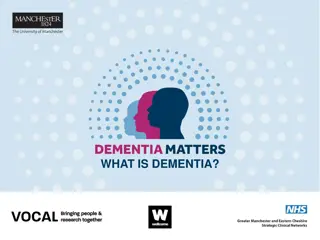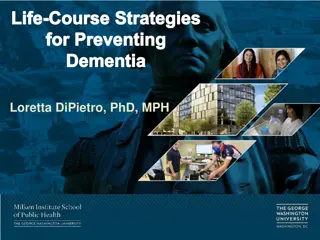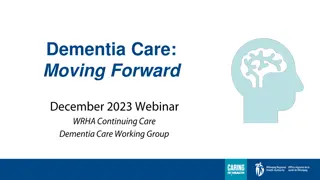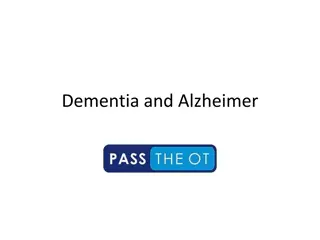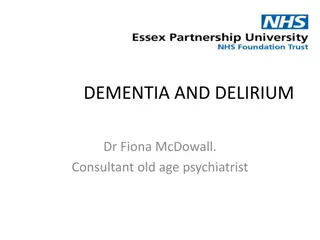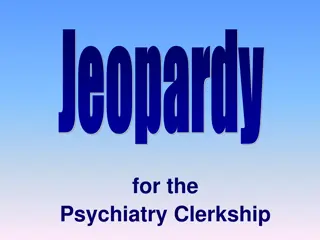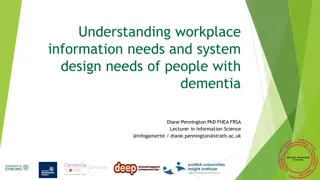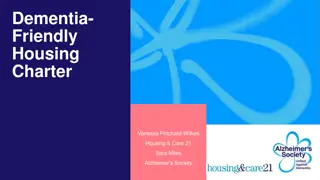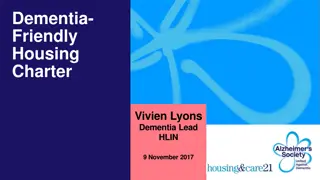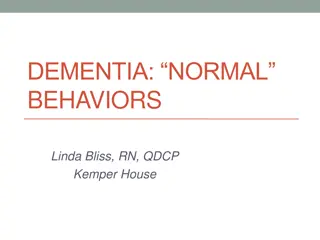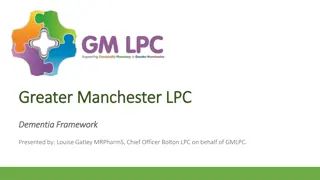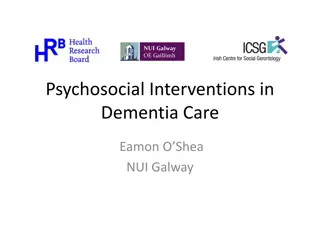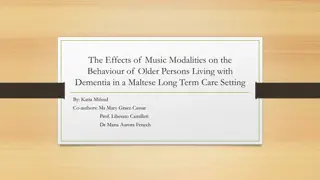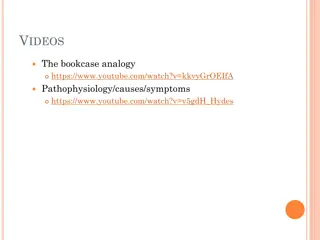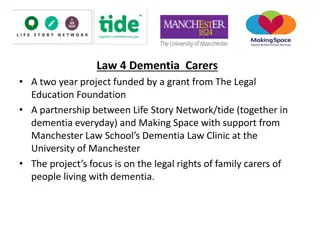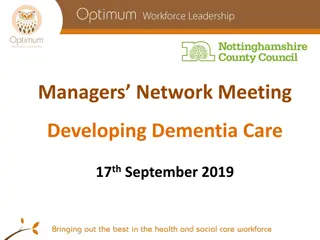Appropriate use of antipsychotics for changed behaviours in people living with dementia
Dementia is characterized by various changes, including behaviours such as wandering, disinhibition, agitation, and aggression. People living with dementia require care that can be approached through non-pharmacological and pharmacological strategies. The overreliance on psychotropic medications like antipsychotics has been highlighted, with associated risks including sedation, falls, stroke, and death. Clinical guidelines emphasize appropriate use of antipsychotics, benzodiazepines, and antidepressants in residential aged care settings.
Download Presentation

Please find below an Image/Link to download the presentation.
The content on the website is provided AS IS for your information and personal use only. It may not be sold, licensed, or shared on other websites without obtaining consent from the author. Download presentation by click this link. If you encounter any issues during the download, it is possible that the publisher has removed the file from their server.
E N D
Presentation Transcript
Appropriate use of antipsychotics for changed behaviours in people living with dementia Education Activity Centre for Medicine Use and Safety (CMUS)
Introduction Background Dementia is associated with a deterioration in:1,2 o Memory o Communication o Thinking o Ability to perform daily activities o Behaviour
Introduction Dementia and changed behaviours People living with dementia often experience changed behaviours. Changed behaviours are diverse and may include: o Wandering e.g. walking aimlessly and/or excessively, attempting to exit a safe location3 o Disinhibition e.g. behaviours that may seem inappropriate or even rude to others3 o Calling out e.g. screaming, groaning, repeated questioning3 o Agitation e.g. excessive fidgeting, pacing, irritability3 o Aggression e.g. verbal insults, swearing, punching, throwing objects2,3 o Psychotic symptoms e.g. sensing things that are not really there (hallucinations), having beliefs that are not based on reality (delusions)2-4
Introduction Care for people living with dementia and changed behaviours Care for people living with dementia and changed behaviours can be split into two broad strategies: Non-pharmacological strategies Pharmacological strategies Definition: medication strategies Definition: non-medication strategies Example: psychotropic medications Examples: pet therapy, exercise therapy, art therapy2,3 Royal Commission into Aged Care Quality and Safety4 defines a psychotropic medication as: Any drug capable of affecting the mind, emotions, and behaviour
Introduction Use of Psychotropic Medications in People Living with Dementia and in Residential Aged Care The Royal Commission into Aged Care Quality and Safety Interim Report: Neglect highlighted an overreliance on psychotropic medications5 Psychotropic medications such as antipsychotics are associated with adverse outcomes for people living with dementia: o Sedation e.g. drowsiness, sleepiness o Falls o Stroke o Death
Introduction Clinical Practice Guideline for Appropriate Use of Psychotropic Medications in People Living with Dementia and in Residential Aged Care Three most common psychotropic medications implicated in restrictive practice in residential aged care are: o Antipsychotics o Benzodiazepines o Antidepressants4 The new clinical practice guideline focuses on the appropriate medication use of antipsychotics, benzodiazepines and antidepressants
Learning Objectives By the end of this session, you should be able to: 1. Explain the criteria that should be met before using an antipsychotic for people living with dementia and changed behaviours 2. Specify the criteria for escalating care surrounding initiation of an antipsychotic 3. Explain what should be documented surrounding initiation of an antipsychotic 4. Be aware of supporting resources accompanying the Guideline to use in everyday practice
Initiation of antipsychotics Image from freepik
Group discussion - what is an antipsychotic?
What is an antipsychotic? Antipsychotics are mainly used to treat psychosis and other psychotic disorders Symptoms of psychosis can include: o Hallucinations - sensing things that are not really there o Delusions - having beliefs that are not based in reality2-4 There are two main types of antipsychotics: o First generation antipsychotics (e.g. haloperidol) o Second generation antipsychotics (e.g. risperidone, olanzapine, quetiapine) Sometimes antipsychotics are prescribed to people living with dementia and changed behaviours One Australian study6 reports 21% of residents are dispensed antipsychotics within three months of admission to residential aged care, with higher rates of antipsychotic use among residents living with dementia
Multiple choice question When should antipsychotics be considered for changed behaviours in people living with dementia? Select the most correct option: a. When a person is initially diagnosed with dementia b. When a person living with dementia is wandering or calling out c. When a person living with dementia is experiencing disinhibition d. When a person living with dementia has distressing psychotic symptoms and/or aggression/agitation that is a direct threat to themselves or others e. All of the above Answer: D
Multiple choice question - answer Why is option D correct? Antipsychotics should only be considered: Antipsychotics should NOT be considered for people living with dementia who are: As a last resort for people experiencing distressing psychotic symptoms and/or aggression/agitation that is a direct threat to themselves or others Initially diagnosed with dementia and not experiencing changed behaviours Calling out Wandering Experiencing disinhibition If a decision is made to initiate an antipsychotic for changed behaviours, the prescriber must clearly indicate the reason for prescribing an antipsychotic
Harms vs benefits of antipsychotics Treat distressing and severe symptoms that pose a direct threat to themselves or those around them:7,8 o Psychosis o Hallucinations o Delusions o Agitation o Aggression Increase the risk of harm of: o Cardiovascular events7 e.g. cardiovascular symptoms, swollen ankles, feet and legs o Sedation7 e.g. drowsiness, sleepiness o Falls and fractures o Extrapyramidal side effects (EPSE)7 e.g. inability to sit still, stiff muscles, shakiness o Stroke7 o Death9 HARMS BENEFITS
Steps before initiating an antipsychotic Clinical steps When a person living with dementia is displaying a changed behaviour for the first time, contact the prescriber to rule out other possible causes (e.g. delirium)10 Communication and documentation steps Document clinical steps trialled and the changed behaviours the person is experiencing in the (where applicable); medical record nursing progress notes behaviour support plan After these have been excluded, all staff should trial the following measures for an adequate and agreed period of time: Identify potential unmet needs such as; loneliness need for social contact need for meaningful activity and discomfort Discuss the person's changed behaviours with the entire care team (including the prescriber) Document conversations and the plan going forward Non-pharmacological strategies Get the entire care team involved!
Case study Joan Smith is an 81-year old person living with Alzheimer s Disease in Sunnyside residential aged care facility While living at home, Joan had a dedicated knitting room where she enjoyed quietly knitting clothes for her family and listening to classical music Joan has been living at Sunnyside residential aged care facility for four years. Joan continues to knit and she is often observed walking around the garden Image from freepik
Case study Small groups Read the Case Study Discuss questions 1 and 2 over the next 15 minutes Prepare answers to share in group discussion
Review of case study questions Group Discussion Question 1. Should an antipsychotic medication be trialled for Joan? What would you communicate and document?
Review of case study questions Group Discussion Question 1. Should an antipsychotic medication be trialled for Joan? What would you communicate and document? Clinical steps No Communication and documentation steps The changed behaviour Joan is experiencing should be documented in the medical record, nursing progress notes and behaviour support plan, where applicable e.g. Joan was experiencing xxxxxx Prescribing, dispensing or administering an antipsychotic in this case should not be considered Non-pharmacological strategies should be trialled for an adequate period of time first Contact the prescriber Notify the care team Antipsychotics should only be considered as a last resort for people experiencing distressing psychotic symptoms and/or aggression/agitation that is a direct threat to themselves or others
Review of case study questions Group Discussion Question 2. List some management strategies you should try first before considering an antipsychotic for Joan. How would you communicate and document this?
Review of case study questions Group Discussion Question 2. List some management strategies you should try first before considering an antipsychotic for Joan. How would you communicate and document this? Clinical steps All staff should trial the following measures and for an adequate and agreed period of time: Communication and documentation steps Document clinical steps trialled and Joan s changed behaviours in the (where applicable); medical record nursing progress notes behaviour support plan Identify potential unmet needs; does Joan need more privacy? does Joan need an optometrist appointment? Contact the prescriber Notify the care team Non-pharmacological strategies; could Joan s yarn be stored in the same location? could staff encourage Joan to spend time in the garden? could staff play classical music Joan enjoys? Document conversations and plan going forward about Joan's changed behaviours We spoke to Joan s daughter (Leslie) who will organise an optometrist appointment for Joan. Leslie asked us to call her in three days to confirm the appointment date and time. Please call Leslie on [date]
Update on Joan The optometrist identified that Joan needed glasses. Staff placed a comfortable chair in Joan s room and created a space where she could comfortably knit in privacy. Leslie comments, I didn t realise Mum needed glasses. But it has made such a huge difference, especially to her knitting projects! And Mum loves the knitting nook in her room. The staff even asked if I could bring in some familiar items to put in Mum s room. Mum really feels at home here at Sunnyside residential aged care facility! Image from freepik
Prescribers' responsibilities surrounding antipsychotic initiation What steps should prescribers complete and document before initiating an antipsychotic? Clinical steps Communication and documentation steps Identify the specific changed behaviour they want to improve (target symptom) Does Joan have distressing psychotic symptoms and/or aggression/agitation that poses a direct threat to herself or others? Have a comprehensive discussion with another health professional Have a comprehensive discussion with the person living with dementia, support person and/or their substitute decision maker Identify the anticipated treatment outcome What benefit does Dr. Mary want to see as a result of Joan taking the antipsychotic? Obtain informed consent Complete an individual harm-benefit analysis What are Joan s individual risks and benefits of taking the antipsychotic? What other medications is Joan taking? Document date to review antipsychotic Document treatment end date If the prescriber initiates an antipsychotic, initial treatment duration for changed behaviours should not exceed 12 weeks
Take home messages There is a limited role for antipsychotics in changed behaviours Before considering initiation of an antipsychotic, all staff should trial for an adequate and agreed period of time: Identify potential unmet needs Non-pharmacological strategies Antipsychotics should only be considered as a last resort for people experiencing distressing psychotic symptoms and/or aggression/agitation that is a direct threat to themselves or others
Supporting resources Access to the Guideline
References 1. The Royal Commission into Aged Care Quality and Safety. Background Paper 3: Dementia in Australia: Nature, Prevalence and Care. Commonwealth of Australia; 2019. Accessed December 9, 2022. https://agedcare.royalcommission.gov.au/sites/default/files/2019-12/background-paper-3.pdf 2. New South Wales Ministry of Health. Assessment and Management of Behaviours and Psychological Symptoms associated with Dementia (BPSD). 2022. Accessed January 25, 2023. https://www.health.nsw.gov.au/mentalhealth/resources/Publications/assessment-mgmt-people-bpsd-2022.pdf. 3. Burns K, Jayasinha R, Tsang R, Brodaty H. Behaviour Management A Guide to Good Practice: Managing Behavioural and Psychological Symptoms of Dementia. Dementia Support Australia; 2012. Accessed September 19, 2022. https://www.dementia.com.au/resource-hub/behaviour-management-a-guide-to-good-practice 4. Aged Care Quality and Safety Commission. Psychotropic medications used in Australia: information for aged care. Australian Government; 2021. Accessed September 2, 2022. https://www.agedcarequality.gov.au/resources/psychotropic-medications-used-australia-information-aged-care 5. The Royal Commission into Aged Care Quality and Safety. Interim Report: Neglect. Commonwealth of Australia; 2019. Accessed September 19, 2022. https://agedcare.royalcommission.gov.au/publications/interim-report 6. Harrison, SL, Sluggett, JK, Lang, C, et al. The dispensing of psychotropic medicines to older people before and after they enter residential aged care. Med J Aust. 2020;212(7):309-313. doi: 10.5694/mja2.50501 7. Maher, AR, Maglione, M, Bagley, S, et al. Efficacy and comparative effectiveness of atypical antipsychotic medications for off-label uses in adults: a systematic review and meta-analysis. JAMA. 2011;306(12):1359-1369. doi: 10.1001/jama.2011.1360 8. Maglione M, Maher AR, Hu J, Wang Z, Shanman R, Shekelle PG, et al. Off-Label use of atypical antipsychotics: An update. Comparative effectiveness review no. 43. Agency for Healthcare Research and Quality. 2011. Accessed September 2, 2022. https://effectivehealthcare.ahrq.gov/sites/default/files/pdf/atypical-antipsychotics-off- label-update_research.pdf 9. Schneider, LS, Dagerman, KS, Insel, P. Risk of death with atypical antipsychotic drug treatment for dementia: meta-analysis of randomized placebo-controlled trials. JAMA. 2005;294(15):1934-1943. doi: 10.1001/jama.294.15.1934 10. Dementia Training Australia. Optimising antipsychotic medication management for responsive behaviour. 2019. Accessed September 2, 2022. https://dta.com.au/resources/optimising-medication-management-for-responsive-behaviour/. Unless specified, all icons included in this presentation are from Flaticon.com





